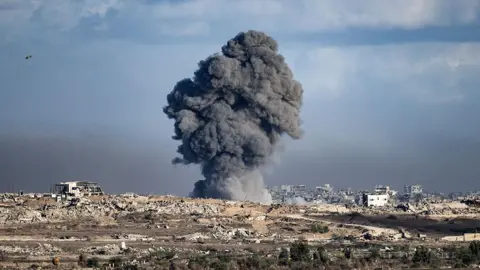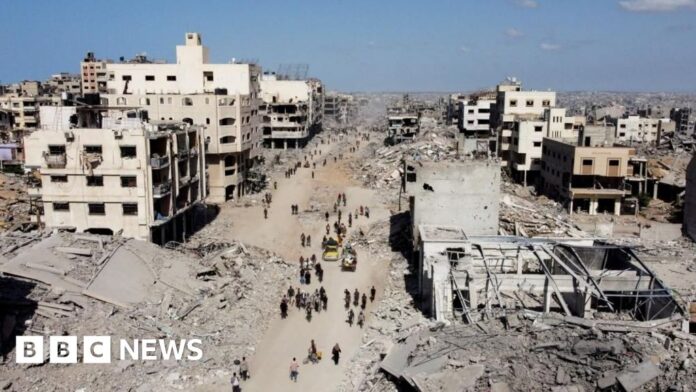 Anadolu via Getty Images
Anadolu via Getty ImagesHamas and Israel are expected are expected to exchange hostages and prisoners on Monday, as part of phase one of Donald Trump’s 20-point peace plan for Gaza.
The agreement, which was announced by Trump on Wednesday, saw a ceasefire come into effect on Friday and increased amounts of aid enter the Strip over the weekend.
Once phase one is complete, negotiations are expected to follow over the details of the latter phases.
Here’s what we know.
What happens next?
Hamas has until 12:00 local time (10:00 BST) on Monday to hand over all living Israeli hostages and as many deceased hostages as it can locate. There are thought to be 48 hostages remaining in Gaza, 20 of whom are believed to be alive.
A spokesperson for the Israeli prime minister’s office said the release of the hostages would begin on Monday morning. They will be collected by the International Committee of the Red Cross (ICRC), which will return them to parts of Gaza controlled by the Israeli military.
From there, they will be transferred to the Re’im military base in Israel where they will be reunited with their families and then taken to hospitals.
During this process, we also expect to see the release of about 250 Palestinian prisoners serving life sentences in Israeli jails and 1,722 detainees from Gaza, including 22 minors.
The names of the prisoners to be released were published by Israel’s justice ministry on Friday. The list does not include seven high-profile names Hamas had demanded as part of the exchange – including Marwan Barghouti and Ahmad Saadat.
According to Israeli media, 100 of the 250 will be released into the West Bank, 15 to East Jerusalem, and 135 will be deported to Gaza or elsewhere.
The identities of the Gaza detainees have not been made public.
A copy of the ceasefire agreement published by Israeli media states the remains of all of the deceased hostages should also be handed over by 12:00 on Monday – but it appears to acknowledge that Hamas and other Palestinian factions may not be able to locate all of them within that timeframe.
It is unclear whether a delay in the release of all deceased hostages could also delay the release of the Palestinian prisoners.
The agreement also states that the handovers will take place “without any public ceremonies or media coverage”. Previous hostage handovers have involved highly choreographed Hamas ceremonies – something the Israeli government wants to avoid.
What else has been agreed in phase one of Trump’s plan?
A ceasefire took effect in Gaza at 12:00 local time (10:00 BST on Friday), according to the Israeli military.
Over the weekend, increased amounts of aid have began entering the territory.
The Israeli military says it has withdrawn to a line detailed in the agreement which leaves it in control of 53% of Gaza, according to a spokesperson for the prime minister’s office.
A map shared by the White House last week indicates this is the first of three stages of Israeli withdrawal, with the other stages intended to occur during the latter phases of Trump’s peace plan.
A multinational force of around 200 troops overseen by the US military will monitor the ceasefire, according to a senior US official. It is believed the force includes troops from Egypt, Qatar, Turkey and the United Arab Emirates.
The official said the role of the force would be to oversee and observe the ceasefire and “make sure there are no violations or incursions”. A second senior US official said no US forces would be on the ground in Gaza.
What about the later phases?
If the hostages and prisoners are succesfully exchanged, it’s believed negotiations will follow over the latter phases of Trump’s 20-point plan.
But many points could be hard to reach an agreement on.
The plan, which you can read in full here, says that if it is agreed by both sides, the war would “immediately end”.
It says Gaza would be demilitarised and all “military, terror and offensive infrastructure” would be destroyed.
It also says Gaza would be initially governed by a temporary transitional committee of Palestinian technocrats – supervised by a “Board of Peace” headed and chaired by Trump and involving former UK Prime Minister Tony Blair.
Governance of the Strip would eventually be handed over to the Palestinian Authority – which administers the West Bank – once it has undergone reforms.
Hamas – which has run the territory since 2007 – would play no future role in its governance, directly or indirectly, according to the plan.
Hamas members would be offered amnesty if they committed to peaceful co-existence, or would be provided safe passage to another country.
No Palestinians would be forced to leave Gaza and those who wished to leave would be free to return.
A “Trump economic development plan to rebuild and energise Gaza” would be created by a panel of experts.
What are the key sticking points?
There are likely to be multiple points of contention during the negotiations over later phases of the deal.
Hamas has previously refused to lay down its weapons, saying it would only do so once a Palestinian state had been established.
The group also made no mention of disarming in its initial response to the plan last weekend, fuelling speculation that its position had not changed.
And though Israel has agreed to Trump’s plan in full, Israeli Prime Minister Benjamin Netanyahu appeared to push back on the Palestinian Authority being involved in a post-war Gaza, even as he stood on the podium next to its president last week.
Hamas has also said it expects to have some future role in Gaza as part of “a unified Palestinian movement”.
Another sticking point is the extent of Israeli troop withdrawal. Israel says its first withdrawal will see it retaining control of around 53% of Gaza. The White House plan indicates further withdrawals to around 40% and then 15%.
That final stage would be a “security perimeter” that would “remain until Gaza is properly secure from any resurgent terror threat”.
The wording here is vague and gives no clear timeline for full Israeli withdrawal – something Hamas is likely to want clarity on.
Source link






